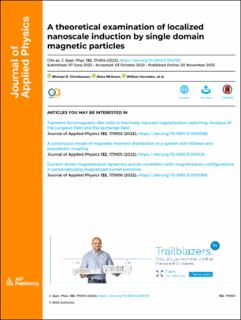| dc.contributor.author | Christiansen, Michael G. | |
| dc.contributor.author | Mirkhani, Nima | |
| dc.contributor.author | Hornslien, William | |
| dc.contributor.author | Schuerle, Simone | |
| dc.date.accessioned | 2022-11-28T09:27:56Z | |
| dc.date.available | 2022-11-28T09:27:56Z | |
| dc.date.created | 2022-11-23T13:50:56Z | |
| dc.date.issued | 2022 | |
| dc.identifier.citation | Journal of Applied Physics. 2022, 132, . | en_US |
| dc.identifier.issn | 0021-8979 | |
| dc.identifier.uri | https://hdl.handle.net/11250/3034375 | |
| dc.description.abstract | Single domain magnetic nanoparticles are increasingly investigated as actuators of biological and chemical processes that respond to externally applied magnetic fields. Although their localized effects have often been attributed to nanoscale heating, recent experimental evidence suggests the need to consider alternative hypotheses. Here, using the stochastic Landau–Lifshitz–Gilbert equation and finite element modeling, we investigate and critically examine an alternative hypothesis that localized effects may instead involve the induced electric fields arising from the dynamical behavior of individual single domain magnetic particles. We model the magnetization dynamics and resulting induced electric fields for two relevant and distinct cases of magnetic nanoparticles in alternating magnetic fields: (1) magnetogenetic stimulation of channel proteins associated with ferritin and (2) catalytic enhancement of electrochemical hydrolysis. For the first case, while the local electric fields that ferritin generates are shown to be insufficient to perturb the transmembrane potential, fields on the surface of its mineral core on the order of 10^2 – 10^3 V/m may play a more plausible role in mass transport of iron ions that indirectly lead to stimulation. For the second case, our model indicates that the highest interfacial electric field strengths, on the order of 10^2 V/m, are expected during reversal events. Thus, nanoparticles well suited for hysteresis heating can also act as intermittent sources of localized induced electric fields in response to an alternating applied field. Finally, we compare the magnitude and timescale of these electric fields to technologically relevant phenomena, showing that they are generally weaker and faster. | en_US |
| dc.description.abstract | A theoretical examination of localized nanoscale induction by single domain magnetic particles | en_US |
| dc.language.iso | eng | en_US |
| dc.publisher | AIP Publishing | en_US |
| dc.relation.uri | https://aip.scitation.org/doi/10.1063/5.0102153 | |
| dc.rights | Navngivelse 4.0 Internasjonal | * |
| dc.rights.uri | http://creativecommons.org/licenses/by/4.0/deed.no | * |
| dc.title | A theoretical examination of localized nanoscale induction by single domain magnetic particles | en_US |
| dc.title.alternative | A theoretical examination of localized nanoscale induction by single domain magnetic particles | en_US |
| dc.type | Peer reviewed | en_US |
| dc.type | Journal article | en_US |
| dc.description.version | publishedVersion | en_US |
| dc.source.volume | 132 | en_US |
| dc.source.journal | Journal of Applied Physics | en_US |
| dc.identifier.doi | 10.1063/5.0102153 | |
| dc.identifier.cristin | 2079292 | |
| cristin.ispublished | true | |
| cristin.fulltext | original | |
| cristin.qualitycode | 1 | |

